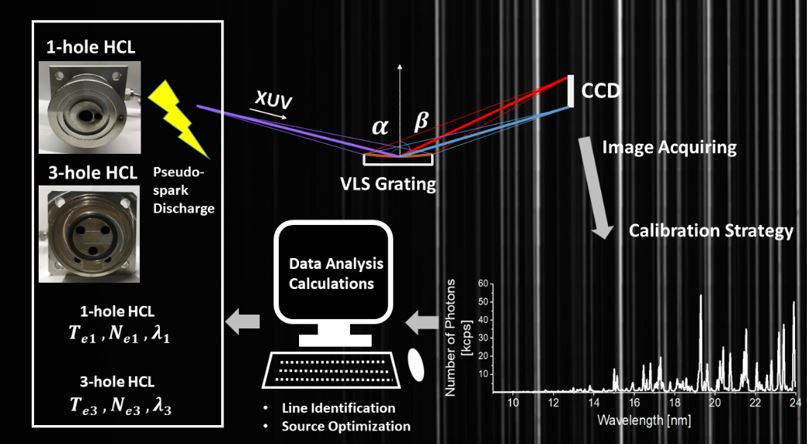Characterization of an Extreme Ultraviolet Hollow Cathode Lamp by means of Plasma Emission Spectroscopy
The development of extreme ultraviolet (XUV) sources has enabled a range of new applications in nano-structuring 1 and spectroscopy 2-4. The quantitative characterization of the XUV emission from a pseudopark hollow cathode lamp (HCL) was carried out with a self-developed flat-field spectrometer for such short wavelength range. However, spectral calibration for XUV spectroscopy is challenging, because the shorter wavelengths show poor resolving power. The flat-field wavelength calibration method presented the highest accuracy in the XUV spectrometer among three alternative calibration methods. The plasma diagnostics were carried out by using the calibrated spectra in the wavelength range of 12-24 nm from the discharged work gas in HCL. The electron temperatures of the discharged N2, O2 and Ar gases in HCL are in the range of 15-18 eV. Moreover, the intensity of the XUV radiation decreased with the increase of work gas pressure, due to self-absorption. Finally, a self-developed one-hole HCL exhibited three orders of magnitude higher electron density (Ne=1.5·1019 cm-3) compared to the state-of-the-art three-hole HCL design (Ne=1016 cm-3), as determined by means of collisional-radiative modeling.

[1] K. Bergmann and L. Juschkin, “Fundamentals and limits for the EUV emission of pinch plasma sources for EUV lithography Thomas Kr ucken,” 2004.
[2] D. Bleiner, M. T. A. Cabas, V. A. Wichser, and Y. E. R. A. N. Tiwari, “XUV laser mass spectrometry for nano ‑ scale 3D elemental profiling of functional thin films,” Appl. Phys. A, vol. 126, no. 3, pp. 1–10, 2020.
[3] O. Sambalova et al., “X-ray absorption spectroscopy probing hydrogen in metals,” vol. 10243, pp. 1–8, 2017.
[4] Y. Arbelo, F. Barbato, and D. Bleiner, “He-doped pseudospark as a home-lab XUV source beyond the beamtime bottleneck,” Plasma Sources Sci. Technol., vol. 26, no. 3, pp. 1–10, 2017.